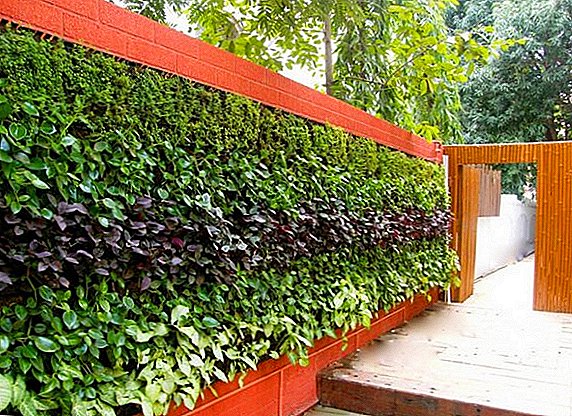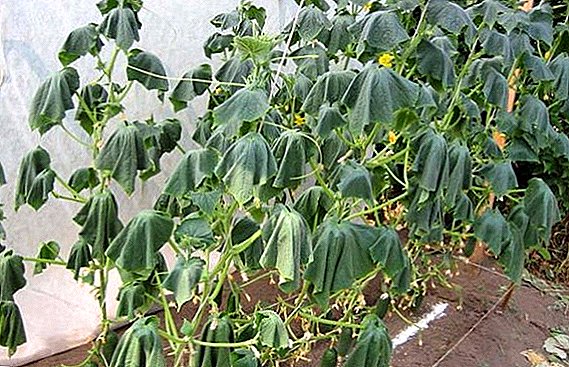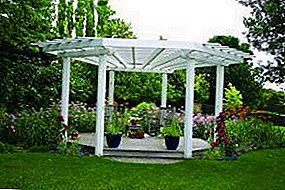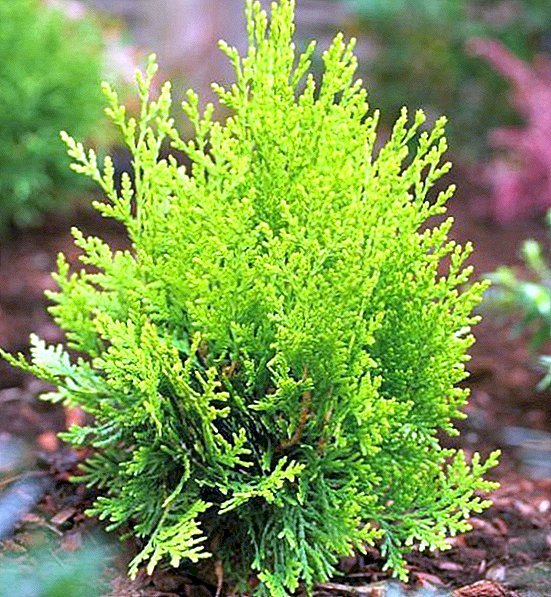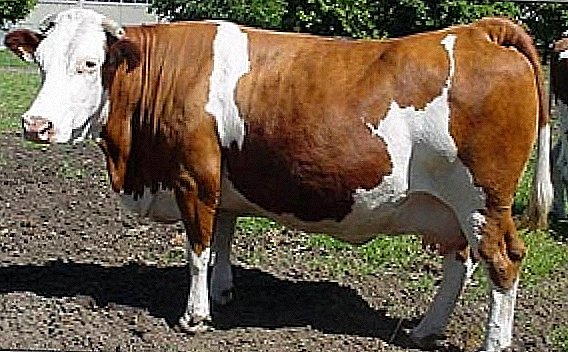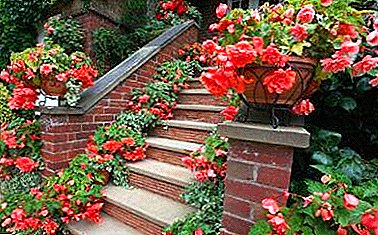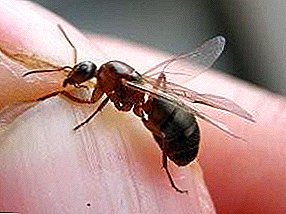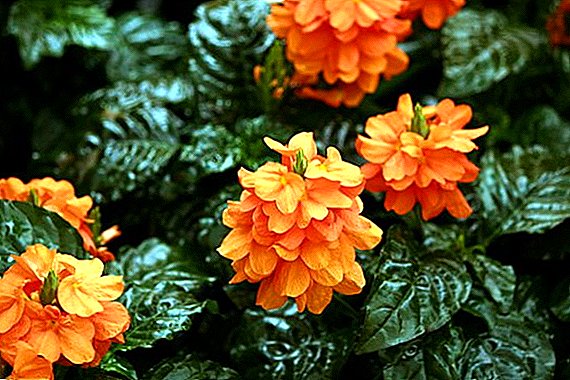 Crossander is a decorative flower with bright colors and glossy, dark green and elegant foliage. It is grown in indoor conditions, but comes from a floral guest from afar.
Crossander is a decorative flower with bright colors and glossy, dark green and elegant foliage. It is grown in indoor conditions, but comes from a floral guest from afar.
Description
The far homeland of the southern guest is India. It is found in crossbands in South Africa. The plant is evergreen, low, shrub. It has dense leathery oval leaves, blooms with yellow, red, pink and orange flowers.
Shrub leaves at the edges have a slightly wavy shape. In the period preceding flowering, the crossander drives up a tall inflorescence - an ear. On this spikelet flowers bloom, the direction of growth of flowers - down, like that of bells. The plant is a member of the Acante family.
For several decades, as the parental form of cross-over has been improved by breeders. Many varieties and hybrid forms have been developed with even more decorative color of flowers.
The most popular among fans of crossbands are:
- hybrid "Mona Walhead" - the variety is bred by a Swedish breeder, a bush up to 50 cm tall, with beautiful and lush foliage, blooms with red flowers;
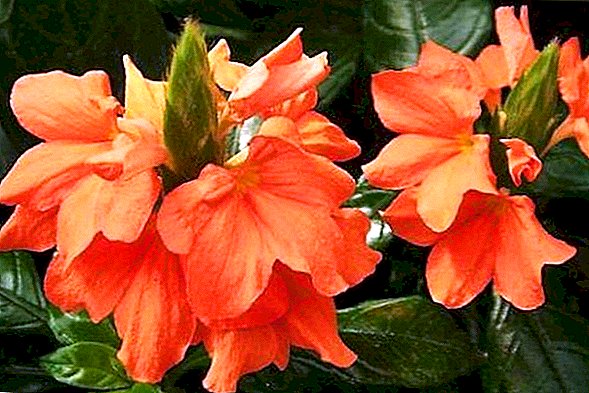
- a series of american hybrid crossander "Tropic" - low-growing bushes (20-25 cm tall) and 20 cm in diameter of the plant. Blossoms salmon orange inflorescences. It is used not only as a houseplant, but also as letniki for gardening flower beds;
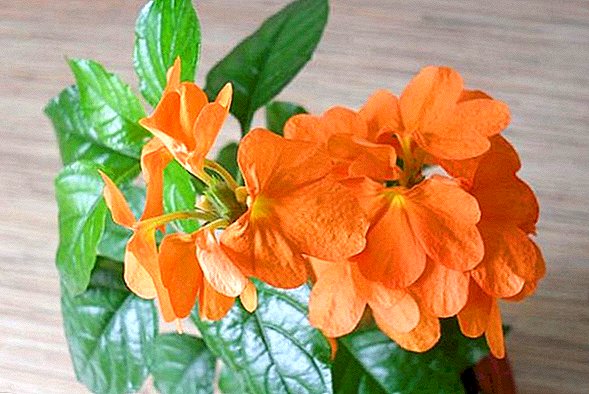
- tall hybrid variety "Orange Marmalade" - height up to 60 cm, with beautiful orange flowers.

Did you know? There are not many varietal varieties. In home cultivation most often used are varieties such as funnel-shaped cross-jordas, a little less prickly and very rarely Nile beauty.
Favorable conditions
Plant growers choose for home cultivation varieties and hybrids with a long flowering period.
But as a resident of the tropics, cross-country needs care in compliance with a special temperature and humidity. Growing at home implies protecting the plant from sudden temperature fluctuations, drafts and pot turns.
In these cases, the bush may respond by dropping the foliage. Grown in compliance with all requirements of the plants reach a height of 60 centimeters. The leaves of the plant also grow twice as big as its wild relatives.
Air humidity and temperature
Shrubs are usually grown in room conditions year-round, with a constant temperature of air from 22 to 27 ° C. In winter, the demanding Southerner suffers a great lack of coverage.
Therefore, flower growers try in the winter time to gradually reduce the air temperature in the room to 18 ° C. At low temperatures, the plant falls into a state of rest, watering at this time is gradually reduced to a minimum.  A very important condition for growing this tropical sissy is high humidity in the room. Crossander is an indoor flower with tropical ancestry, and in winter it needs special care.
A very important condition for growing this tropical sissy is high humidity in the room. Crossander is an indoor flower with tropical ancestry, and in winter it needs special care.
During the heating period, the air in the room is constantly dry, and the flower responds to the dryness of the yellowed edges of the leaves, drying out the base of the leaf (petiole), and as a result the plant drops the leaves.
To increase the humidity of the florist many techniques:
- next to the flowers set containers with water;
- a flower is sprayed daily from a spray;
- the plant is transferred closer to the aquarium;
- place all indoor flowers in one dense group;
- under the pot with a flower set pan, filled with small pebbles and water.
Important! When spraying a shrub, you should avoid direct contact with moisture on the flowers, as they easily fall off.
In the summer hot period, a cross-over can be placed on the street or on the outdoor terrace (veranda). The main thing - do not allow the flower to fall direct sunlight. With the onset of autumn, the plant is again transferred to the room. 
Lighting
Crossander loves the sun and warmth, but does not tolerate contact with the leaves in direct sunlight, preferring soft and diffused light. Therefore, it is best for plants to fit windows of any orientation, except the south window.
True, on the north window during the winter period the cross-country may not bloom for a long time. In this case, she needs to install additional lighting with a special fitolampa. If there is no choice where to place the flower, then feel free to place it on the southern window, but with mandatory shading from the sun with white paper.
Capacity and Substrate
Perennial likes neutral or slightly acidic soil. Wanting to comfortably arrange perennial for permanent residence, you need to mix the soil mixture before planting:
- 1 part turf soil;
- 1 part of river coarse or quartz sand;
- 2 parts of leafy soil (from under birch or maple).

Did you know? If you prefer to buy ready-made soil for transplanting a flower, pay attention to the soil for azaleas. Azaleas and crossbands have the same requirements for soil composition. Such a soil mixture can be purchased at any garden center or seed shop.
Transplant after purchase
- Before laying the soil in a flower pot should be laid on the bottom of the pot drainage. Drainage may consist of broken clay shards or expanded clay and allows you to avoid rotting of the roots with excessively abundant watering. Thanks to the drainage, the moisture does not stagnate, but flows into a tray under a flower pot.
- Crossander needs a transplant every year. When replanting a flower at home, you need to change the soil to a fresh one, since the flower from last year’s land pulled out all the useful minerals. Good care provides for an annual transplant of a slightly larger pot.
- During transplantation, the plant is inspected, trimmed or shaped if necessary. If the florist needs another plant, the perennial can be divided in two. To do this, the roots are neatly divided in half with a pruner.
- It is difficult to replant an adult cross-country shrubber, therefore, starting from the fifth year of cultivation, the plant is replanted every 3-4 years. When transplanting an adult bush, a method of careful transfer to a larger pot is used. The voids in the new tank are filled with fresh soil. A pot for adult crossseed choose a size of at least 20-30 liters.
- In the year when no transplant is done, the top layer of the soil is removed (to a depth of 5 cm) and a new soil is poured. This procedure is needed bush every spring.

Care provision
In order for the flowering shrub not to lose its ornamentation, it is necessary to regularly remove dried flowers. This procedure extends the period of flowering of the plant itself. When no flower remains in the inflorescence, the inflorescence is carefully cut by a garden shears at the base of the top pair of leaves.
Loosening the soil at the base of the bush, watering, protection from pests, the accompanying temperature and fertilizer - the key to lush and long-term flowering.
Watering
Moistening a bush, it is impossible to fill in strongly the soil in a pot. From this, the ground in the tank may oxidize, and the root system of the bush will rot. But the cross-country does not tolerate both a prolonged drought and the drying up of the soil in a pot. Watering should be regular, and earthen clod plants slightly moist.
The flower loves soft melt water or rainwater. But the water from the tap in the city apartment is also suitable. Tap water is collected in advance and before using it for watering plants defend for at least a week. When watering water should be at room temperature.
Watering indoor shrubs, it is necessary to prevent the wetting of flowers. A couple of hours after watering, all the excess water from the pot is drained from the pallets.
Since the cross-country is native to the tropics, its irrigation takes into account the peculiarities of the weather seasons of its homeland. In its natural environment, the bush is at rest for two months (September and October).  When growing a flower in room culture:
When growing a flower in room culture:
- Six months, from November to August, the plant is biologically active period. At this time, it increases the leaf mass and blooms. He needs a sufficient amount of moisture, watering 3-4 times a week. In addition to basal watering, perennial needs regular spraying on the sheet. Leaves can be wiped with a damp sponge, it not only moisturizes the plant, but also removes dust.
- From September to October, the plant gradually falls into a dormant period. Shrub less often begin to water, reduce and leaf moistening. The transition from active irrigation carried out smoothly. First, perennial watering is reduced to two per week, and a little later, and once every ten days.
This is an approximate frequency of watering during the rest period, a more accurate one can be determined as follows: if the soil in the pot on top is completely dry, then the plant requires moisture.
Important! Cross-country, affected by drought, can be saved, and overmoistened will inevitably perish. Especially dangerous is excess moisture for perennial room in winter.
Fertilizer
Special love florist crossander earned a long period of flowering. But flowering depletes the plant, so the perennial needs soil and leaf top dressing.
For perennial fertilizer, ready-made store complex mixtures for flower dressings are suitable. Such dressings are dissolved in water for irrigation and weekly added to the plant root.  As soon as the shrub enters the period of rest - mineral supplements cease.
As soon as the shrub enters the period of rest - mineral supplements cease.
Application Schedule:
- spring and summer - once every 14 days;
- in autumn and winter - once a month.
Pruning
Crossandra needs periodic pruning. This procedure contributes to the formation of a beautiful, fluffy cap at the flower.
To aesthetically looking bush, all young twigs pinch. A nip shortens a branch by one third of the length, after which the lateral buds wake up on it, and the bush enters the phase of active branching.
When grown in winter, the plant leaves the rest period in March. It is recommended to conduct a strong pruning in February. With this pruning, the height of the stems is shortened by half.
Did you know? All branches remaining after pruning or trimming can be put into the water for rooting. After the twig throws white roots, the stalk is planted in a pot.
Disease and pest resistance
Crossander, like other indoor plants, is periodically exposed to invasions of spider mites, aphids, and worm. For treatment, a plastic bag is thrown onto the affected plant, and under it the perennial is already sprayed with insecticides.
After processing, the flower is left in a plastic wrap for 40 minutes. After that, the film is removed, and the room is ventilated. If you do not carry out timely treatment from pests, the plant may die.  Attention perennial need not much, but constantly. The whole secret of the lush flowering and gorgeous view of the plant is in a well-chosen place where the flower is installed, sufficient mineral nutrition, lack of draft and the presence of warm and humid air.
Attention perennial need not much, but constantly. The whole secret of the lush flowering and gorgeous view of the plant is in a well-chosen place where the flower is installed, sufficient mineral nutrition, lack of draft and the presence of warm and humid air.
If all the conditions for the comfort of the flower are met, then it will be easy to care for him. Amazing decorative perennial decorate your apartment and your life.






